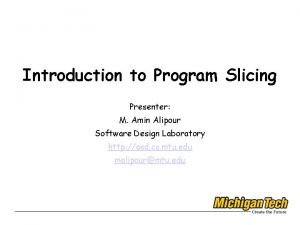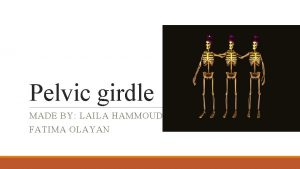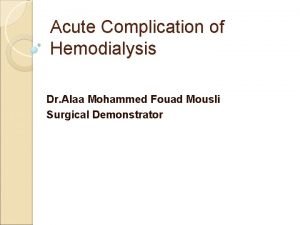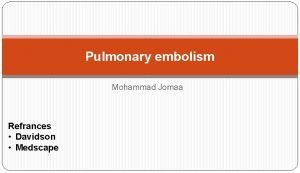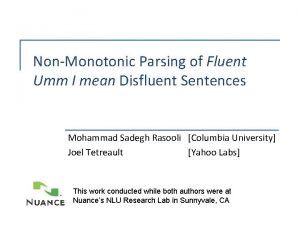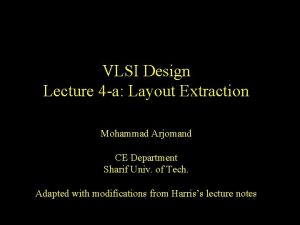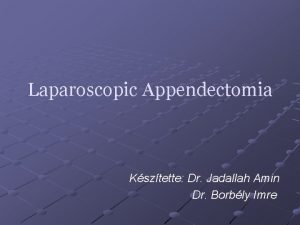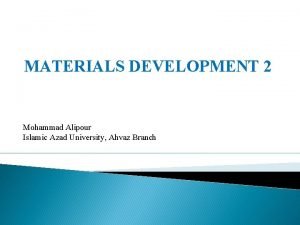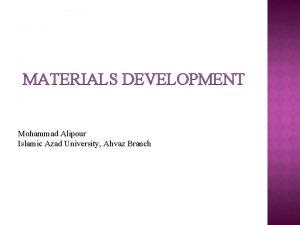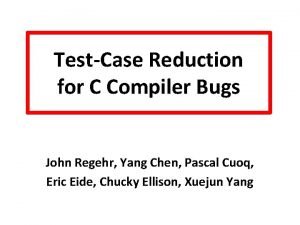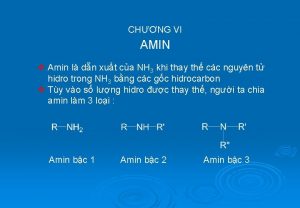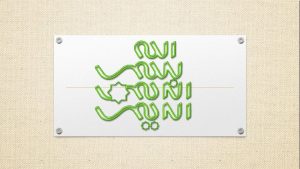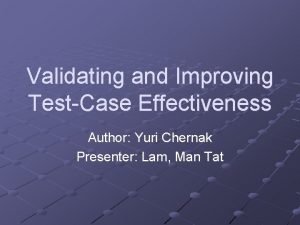Evaluating Nonadequate TestCase Reduction Mohammad Amin Alipour August

































- Slides: 33

Evaluating Non-adequate Test-Case Reduction Mohammad Amin Alipour, August Shi, Rahul Gopinath, Darko Marinov, and Alex Groce ASE 2016 Singapore, Singapore September 5, 2016 CCF-1054876 CCF-1409423 CCF-1421503 1

Announcement Amin is on the job market! alipourm@oregonstate. edu http: //alipourm. github. io/ Rahul is on the job market! gopinathr@oregonstate. edu http: //rahul. gopinath. org/ 2

Testing Can Be Slow T 1 T 2 T 3 T 4 . . . Tn 3

Test-Suite Reduction T 1 T 2 T 3 T 4 . . . T 3 Tn Tn Still satisfies all test requirements 4

Non-adequate Test-Suite Reduction T 1 T 2 T 3 T 4 . . . T 3 Tn Tn Satisfies almost all test requirements 5

Test-Case Reduction T 1 T 2 T 3 T 4 T 1 ’ T 2 ’ T 3 ’ T 4 ’ . . . Tn Tn ’ Each test case still satisfies same test requirements 6

Our Work: Non-adequate Test-Case Reduction T 1 T 2 T 3 T 4 T 1 ’ T 2 ’ T 3 ’ T 4 ’ . . . Tn Tn ’ Each test case satisfies almost same test requirements 7

Non-adequate Test-Case Reduction: Approaches • Reduce test cases without preserving all test requirements • We propose two approaches: • C%-Coverage: coverage-based non-adequate test-case reduction • N-Mutant: mutant-based non-adequate test-case reduction 8

Non-adequate Test-Case Reduction: Metrics • We evaluate with three metrics: • Size Reduction Rate (SRR): how much test case is reduced • Coverage Preservation Rate (CPR): how much coverage does reduced test case preserve • Mutant Preservation Rate (MPR): how many killed mutants does reduced test case preserve 9

Adequate Test-Case Reduction (Coverage) To’’ To Covers lines: 1, 2, 4, 7, 8 To ’ Covers lines: 1, 2, 4, 7, 8 . . . Tr 1 -minimal Covers lines: 1, 2, 4, 7, 8 Cause Reduction (based on Delta Debugging)* *Groce, A. , Alipour, M. , Zhang, C. , Chen, Y. , and Regehr, J. Cause reduction for quick testing. ICST 2014 10

Adequate Test-Case Reduction (Mutants) To’’ To To ’ Kills mutants: M 1, M 3, M 7, M 10 . . . Tr 1 -minimal Kills mutants: M 1, M 3, M 7, M 10 11

Non-adequate Test-Case Reduction Non-adequate Reduction C%-Coverage Preserve at least C% of coverage N-Mutant Adequate Reduction C=100 Preserve at least N specified mutants killed N=all killed mutants 12

C%-Coverage vs. N-Mutant: 3 Differences Test Requirement Percentage vs. Absolute Changing vs. Fixed Test Requirements C%-Coverage Lines Covered Percentage Any C% lines covered N-Mutant Absolute Fixed N killed mutants Mutants Killed 13

C%-Coverage To’’’ To Covers lines: 1, 2, 4, 7, 8 To ’ Covers lines: 1, 2, 4, 7, 8 . . . Tr Covers lines: 1, 2, 4, 7, 8 C = 80 14

N-Mutant To’’’ To To ’ Kills mutants: M 1, M 3, M 7, M 10 . . . Tr Kills mutants: M 1, M 3, M 7, M 10 N=3 {M 3, M 7, M 10} 15

Metrics • Size Reduction Rate (SRR) • Coverage Preservation Rate (CPR) • Mutant Preservation Rate (MPR) 16

Research Questions • RQ 1: How much are test cases reduced (SRR)? • RQ 2: How much are code coverage and mutants killed preserved (CPR and MPR)? • RQ 3: How do SRR, CPR, and MPR trade off? • RQ 4: How do CPR and MPR for our approaches compare to CPR and MPR for random test-case reduction? See paper for RQ 4 evaluation 17

Experimental Setup • C from {70, 80, 95, 100} • Coverage measured using GCov • N from {1, 2, 4, 8, 16, 32} • Mutants generated using Andrews et al. mutation tool* • Randomly sampled mutants • See paper for evaluation using minimal mutants • Reduction timeout of 30 minutes per test case 18 *Andrews, J. , Briand, L. , and Labiche, Y. Is mutation an appropriate tool for testing experiments? ICSE 2005

Projects Project # Test Cases What is Removed # Mutants Min. Killed Max. Killed Spider. Monkey 99 Java. Script statement 69, 067 8, 101 12, 825 YAFFS 2 99 API call 15, 046 2, 071 3, 439 7, 591 19 993 7, 175 1, 813 2, 046 Grep Gzip 112 Character in command line 73 Byte Experiments use N from 1 to 32, small percentage of min killed 19

RQ 1: Size Reduction Rate (SRR) C%-Coverage Median SRR > 50% for non-adequate 20

RQ 2: Coverage Preservation Rate (CPR) N-Mutant Median CPR close to 80% with just one mutant! 21

RQ 2: Mutant Preservation Rate (MPR) N-Mutant Relatively high MPR with even just one mutant! 22

RQ 3: SRR vs. CPR (YAFFS 2) C%-Coverage N-Mutant 23

RQ 3: SRR vs. MPR (Spider. Monkey) C%-Coverage N-Mutant 24

RQ 3: CPR vs. MPR C%-Coverage N-Mutant 25

RQ Highlights • RQ 1: High SRR difference from adequate to nonadequate • RQ 2: High CPR/MPR even with low non-adequacy, e. g. , N=1 for N-Mutant • RQ 3: Higher SRR trades off lower CPR/MPR; high CPR tends to imply high MPR • Not so clear trade-offs in case of N-Mutant 26

Conclusions • We propose non-adequate test-case reduction • Non-adequate test-case reduction: • Provides high size reduction and still largely preserves quality • C%-Coverage offers substantial size reduction with controlled loss in coverage • N-Mutant shows just preserving small number of mutants can still preserve a large percentage • High dependency among mutants needs more investigation awshi 2@illinois. edu 27

BACKUP 28

Minimal Mutants vs. 1 -Mutant 29

C%-Coverage vs Random (baseline) 30

N-Mutant vs Random (baseline) 31

Interdependency between Mutants 32

Reduction Time 33
 Mohammad alipour
Mohammad alipour Amin alipour
Amin alipour Public class test subject extends test class
Public class test subject extends test class Babak alipour
Babak alipour Mohammad sharifkhani
Mohammad sharifkhani Mohammad ghoreishi
Mohammad ghoreishi Dr nur mohammad hadi zahalan
Dr nur mohammad hadi zahalan Mohammad irfan bowdoin
Mohammad irfan bowdoin Mohammad ridwan bkn
Mohammad ridwan bkn Dr mohammad aman
Dr mohammad aman Shaik mohammad tajuddin
Shaik mohammad tajuddin Mohammad hammoud
Mohammad hammoud Alaa mohammad fouad
Alaa mohammad fouad Pearo-nn
Pearo-nn Kongres melayu 1939 dan 1940
Kongres melayu 1939 dan 1940 Modified wells score
Modified wells score Mohammad sharifkhani
Mohammad sharifkhani Anovulation who classification
Anovulation who classification My.edu.sharif
My.edu.sharif Mohammad alomar
Mohammad alomar Mohammad arjomand
Mohammad arjomand Dr mohammad khan
Dr mohammad khan Mohammad sadegh rasooli
Mohammad sadegh rasooli Mohammad sharifkhani
Mohammad sharifkhani Dr mohamed bashar shala
Dr mohamed bashar shala Mohammad ali javidian
Mohammad ali javidian Mohammad ali abtahi
Mohammad ali abtahi Mohammad arjomand
Mohammad arjomand Dr mohammad aman
Dr mohammad aman Mohammad keshavarz
Mohammad keshavarz Peyman milanfar
Peyman milanfar đốt amin
đốt amin Realativ
Realativ Hydroliza amidów
Hydroliza amidów

